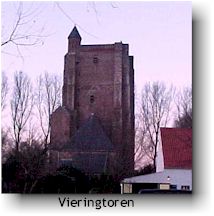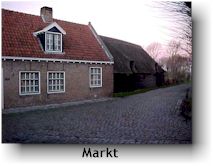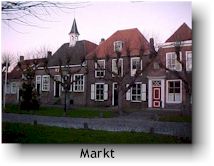|
Picture: market square of Bruges |
| start > gb > arounddamme > sint-anna-ter-muiden |
|
» Aardenburg » Abbey of Ter Doest » Adegem » Bruges » Castle of Middelburg » Donk » Dudzele » Fort of Bavaria » Knokke-Heist » Koolkerke » Lissewege » Maldegem » Male » Middelburg » Oedelem » Sint-Anna-Ter-Muiden » Sluis |
Sint-Anna-ter-Muiden
The village developped very fast, received town rights in 1242 and already became member of the Flemish Hansa in Londen in 1252. Hardly one century later already all went to go downhill.
The church tower is the only remaining witness of the turbulent history of Muyden. This tower dates back to the 14th century and even survived the 80-years war between Spain and the Northern Netherlands. The size of the monumental tower is not in the right proportions in relation to the rest of the church. The choir is much younger and was built when the town was not so prosperous anymore. 1653 to be precise. When you enter the village, you can't miss the large pump on the market square. This pump dates back to 1789 and is in Louis XIV-style. On this square you also have the "Raadhuis" (municipality), where regularly exhibitions are organized. The village used to be a safe haven for artists in the beginning of the 20th century. The entire village is a protected monument. Here, you can still see houses with thatch roofs. In 1880, the village was annexed to Sluis. How to get in St.-Anna Ter Muiden? From the center of Damme: by car the easiest way is to follow the Damse Vaart in the direction of Sluis. When you're in Hoeke, take the N49/E34 in the direction of Knokke-Heist. At the first traffic lights you go right. Follow this road and you will end up in Muyden. Bikers can take a far more beautiful road: in Hoeke you continue alongside the Damse Vaart in the direction of Sluis. Once you are in Sluis, it's only a few minutes to Muyden. Worth seeing: church and tower, pump, market square and surrounding buildings.
|
|
|
© Hendrik De Leyn - www.damme-online.com |

 At
only a few hundred meters from the Belgian-Dutch border lies the
pictoresque village of St.-Anna ter Muyden (St.-Anna ter Muiden).
The name probably originates form the English word 'mouth',
which became 'mude' in Flemish. Mude came to existence around
1200, so long before
At
only a few hundred meters from the Belgian-Dutch border lies the
pictoresque village of St.-Anna ter Muyden (St.-Anna ter Muiden).
The name probably originates form the English word 'mouth',
which became 'mude' in Flemish. Mude came to existence around
1200, so long before
 It
looks like a bad habit of foreign rulers to plunder the ports of
the Zwin. These settlements were rich and prosperous and not
everywhere there were fortifications. This of course made them
a very attractive pray. Furthermore, the foreign politics of
powerful
It
looks like a bad habit of foreign rulers to plunder the ports of
the Zwin. These settlements were rich and prosperous and not
everywhere there were fortifications. This of course made them
a very attractive pray. Furthermore, the foreign politics of
powerful

